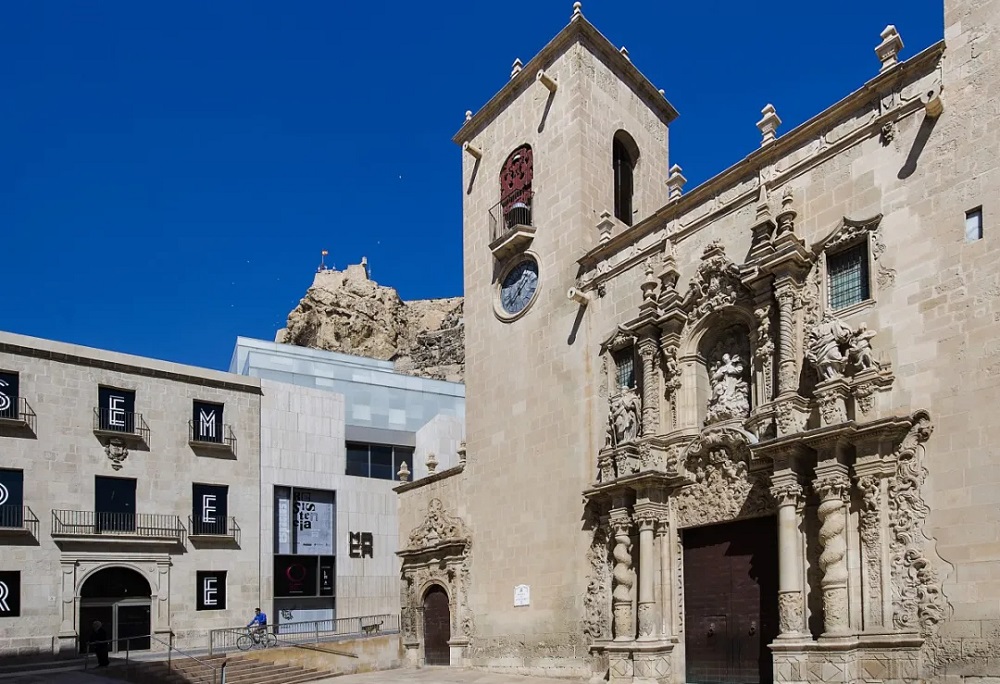Alicante, a picturesque coastal city in the Valencian Community of Spain, is not only known for its sun-drenched beaches and vibrant atmosphere but also for its rich cultural heritage. One of the city’s most treasured landmarks is the Santa María Basilica, a stunning architectural masterpiece that reflects centuries of history and artistic evolution. In this article, we delve into the captivating history, architectural styles, and artistic wealth of the Santa María Basilica, inviting you to explore the wonder of this sacred site.
Also read: 16 Things to do in Javea
A Brief History
The Santa María Basilica, or Basílica de Santa María in Spanish, is the oldest active church in Alicante. Its construction began in the 14th century on the site of a former mosque, following the Reconquista of the city by the forces of King James II of Aragon. Over the centuries, the basilica underwent several renovations and expansions, resulting in a fascinating fusion of architectural styles that continue to captivate visitors today.
Architectural Styles
The Santa María Basilica is a magnificent showcase of diverse architectural styles, primarily Gothic and Baroque. The Gothic influence is evident in the basilica’s original structure, characterized by its pointed arches, ribbed vaults, and flying buttresses. The side chapels, dating back to the 15th and 16th centuries, also exhibit Gothic elements, further contributing to the basilica’s medieval charm.
The Baroque influence is most prominently displayed in the basilica’s elaborate façade, which was constructed during an 18th-century renovation. Designed by the architect Juan Bautista Borja, the façade is adorned with intricate sculptures and relief work, providing a striking contrast to the church’s Gothic origins.
Artistic Treasures
The Santa María Basilica is home to a wealth of artistic masterpieces that offer a glimpse into the region’s vibrant cultural history. One of the most notable pieces is the rococo-style high altar, which was designed by Nicolás de Bussy in the 18th century. This impressive work of art is made from gilded wood and features an array of intricate carvings and sculptures, including a depiction of the Assumption of the Virgin Mary, to whom the basilica is dedicated.
Another significant treasure is the baptismal font, which dates back to the 15th century and is crafted from Carrara marble. The font is adorned with Gothic tracery and detailed relief work, further highlighting the basilica’s rich artistic heritage.
Visiting Santa María Basilica
The Santa María Basilica is open to visitors, who are welcome to attend daily mass or simply explore the captivating interior of the church. Guided tours are also available for those who wish to learn more about the history, architecture, and art of this unique site. More information about visiting hours, events, and guided tours can be found on the Alicante Turismo website at https://www.alicanteturismo.com/basilica-de-santa-maria/.
Getting to Santa María Basilica in Alicante from Jávea
Santa María Basilica in Alicante is an essential destination for anyone visiting the Valencian Community. This description outlines how to get to Santa María Basilica from Jávea using various modes of transportation.
By Car:
The most convenient way to travel from Jávea to Santa María Basilica is by car. The journey takes approximately 1 hour and 15 minutes, depending on traffic. To start your trip, head south on the CV-735 towards Alicante. Continue onto the N-332 and then take the exit toward A-70/AP-7. Merge onto the A-70/AP-7, and after about 61 kilometers (38 miles), take exit 67 for Alicante.
Follow signs for the city center (Centro Ciudad) and then look for parking nearby. There are several parking lots and garages within walking distance of the basilica. Santa María Basilica is situated in the old town of Alicante, which can be easily explored on foot.
By Public Transportation:
You can also travel from Jávea to Alicante using public transportation. Start by taking the bus from Jávea to the nearby town of Denia. The bus line is operated by Autocares Carrió, and the journey takes around 30 minutes. You can find more information and book tickets at their website: https://carriogroup.com/
Once in Denia, transfer to a tram (TRAM Metropolitano Alicante) at the Denia Tram Station. Take Line 9 towards Benidorm. At the Benidorm Tram Station, transfer to Line 1, heading towards Alicante. You can find more information and buy tickets at the TRAM Metropolitano Alicante website: https://www.tramalicante.es/
Get off at the Alicante Mercado Tram Station. From there, it’s a short 5-minute walk to Santa María Basilica. Head southwest on Av. Alfonso X El Sabio, turn right onto Calle San Francisco, and then turn left onto Calle San Agatángelo. The basilica will be on your left.
By Taxi or Rideshare:
Alternatively, you can take a taxi or use a rideshare service like Uber or Cabify for a more direct and comfortable journey. The cost will be higher compared to public transportation, but it can save you time and the hassle of transfers.
Regardless of the mode of transportation you choose, the trip from Jávea to Santa María Basilica in Alicante promises to be a memorable experience, as you discover the beauty and history of the Valencian Community.
Conclusion
A visit to the Santa María Basilica in Alicante offers a captivating journey through the city’s rich artistic and historical heritage. The enchanting fusion of Gothic and Baroque architecture, coupled with the basilica’s impressive collection of artistic treasures, creates an unforgettable experience for visitors. No trip to Alicante would be complete without exploring this awe-inspiring landmark and the stories it has to tell.


